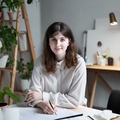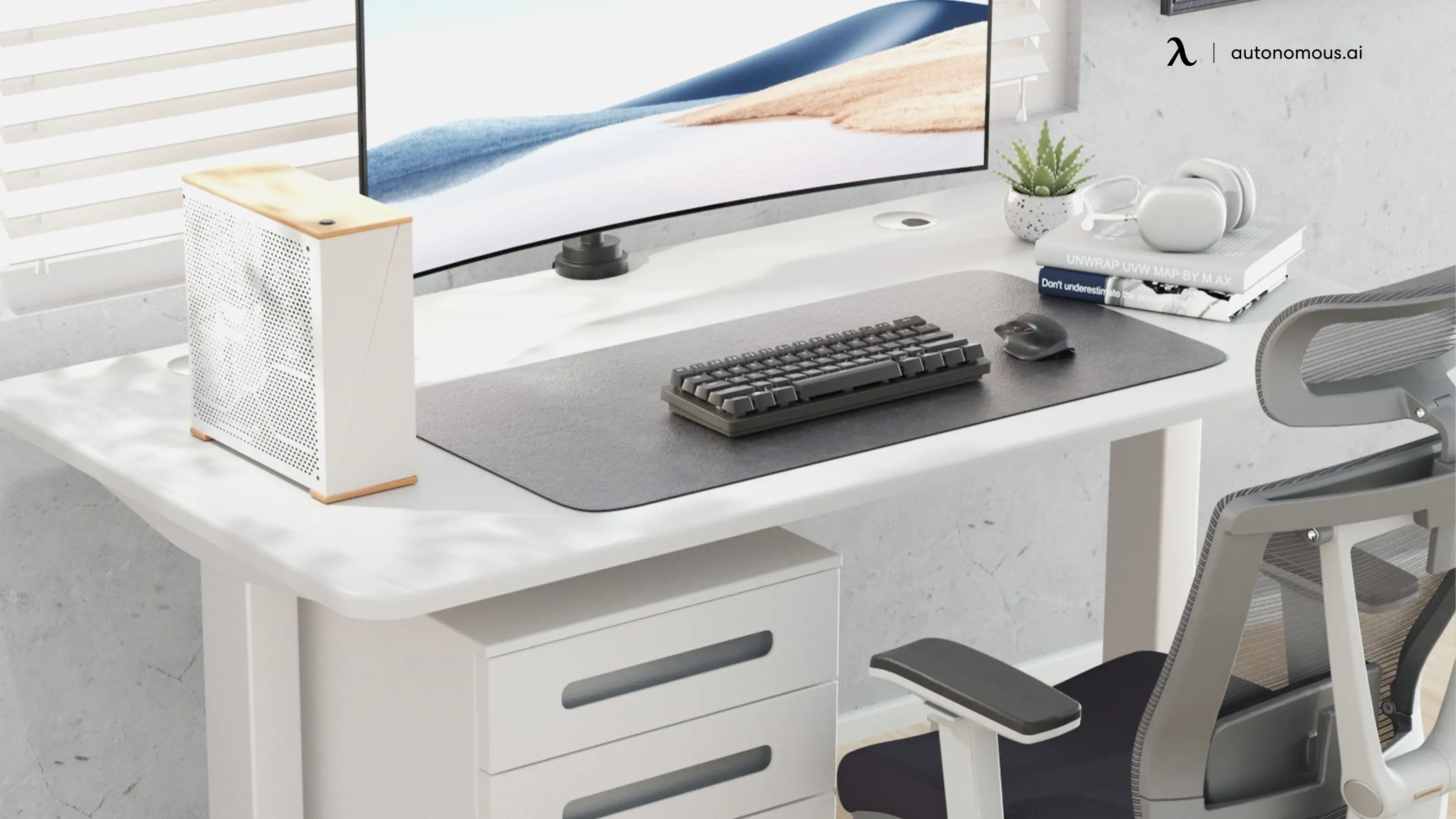
Table of Contents
For accountants, their desk is more than just a place to work—it’s the space where critical thinking, organization, and focus happen. Given the nature of their job, accountants spend long hours at their desks, often working with numbers, spreadsheets, and important documents. The environment in which they work can directly influence productivity, comfort, and overall job satisfaction.
The right decor theme for an accountant desk setup can significantly improve focus, efficiency, and even reduce stress levels. Whether you are an accountant working from home, in an office, or in a shared workspace, creating the ideal desk setup is crucial. This blog will explore importance of ergonomics, various decor themes for accountant desk setups, covering everything from minimalist designs to eco-friendly spaces.
What Is an Ergonomic Workstation?
Most people have asked themselves, ‘What is an ergonomic workstation?’ You know you need one, but you don’t know what it means.
An ergonomically correct workstation is one that has the appropriate tools. The desk and chair heights are essential and allow you to sit or stand up straight. You also use a keyboard and mouse that reduces hand fatigue. Any other equipment, such as a second monitor, is positioned correctly.

How to Set Up an Ergonomic Accountant Desk
What is an ergonomic workstation? We’ve answered this, but now we have to discuss how to set up an ergonomic workplace. This is going to involve many steps, so let’s get started:
1. Set the Chair
Your ergonomic workstation setup should start with the chair. However, most people adjust their computer monitors first, but this often doesn’t work out for you. Generally, people sit down when they begin working. It’s imperative that you’re sitting up straight and your spine is perfectly aligned.
What is an ergonomic workstation? It starts with how you sit. Make sure that you choose an ergonomic chair so that you can adjust the height.
To do this effectively, you should sit down in the chair at the highest setting. Adjust it so that your legs are about parallel with the floor and keep your feet flat. Don’t put pressure on the feet and press them into the floor. Just let them rest normally.
2. Various Chair Options
Learning how to set up an ergonomic workplace is easy, but it can take time. Don’t rush this step. When you get your ErgoChair Pro, you must put it together and adjust it for your particular needs. You’ve got the right height now, so you can work on the minor adjustments.
Move the headrest up or down and tilt it so that your head is in alignment with the spine. Sit up straight and adjust the lumbar support until you feel that you can hold that position comfortably for long periods.
You can also move your seat forward, adjust the armrests, and so much more. Of course, the height is the most important thing in the ergonomic workstation setup, especially for the next step.
An alternative to the ErgoChair Pro is the ErgoChair Ultra 2. This works well in any ergonomic office setup. It uses advanced TPE material with a fishbone design to support the back and promote a healthy spine. With time, it can correct your posture while sitting. You can adjust the height, seat, armrests, and back-tilt with it as well.
3. What about Tall People?
When asking, ‘what is an ergonomic accountant desk setup?’ most of the focus is on average or short people. But what if you’re very tall?
Your body’s ideal positioning stays the same, but this often means lowering the chair too much for the legs and feet. You should always check the chair measurements, but getting a standing desk can alleviate some of the problems tall people face. Position the chair so that you sit comfortably. Then, adjust the desk to ensure that the elbows are at the sides at 90 degrees.
4. Set the Desk
The next step in your ergonomic office setup is to adjust your desk to the correct height. Most traditional ones don’t allow this, which is why many people switch to a standing desk. You can change the height from a seated position to a standing one. Even if you never plan to stand and work, it allows you to set it up for the best elbow and hand placement while typing. This is essential when learning how to set up an ergonomic workplace.
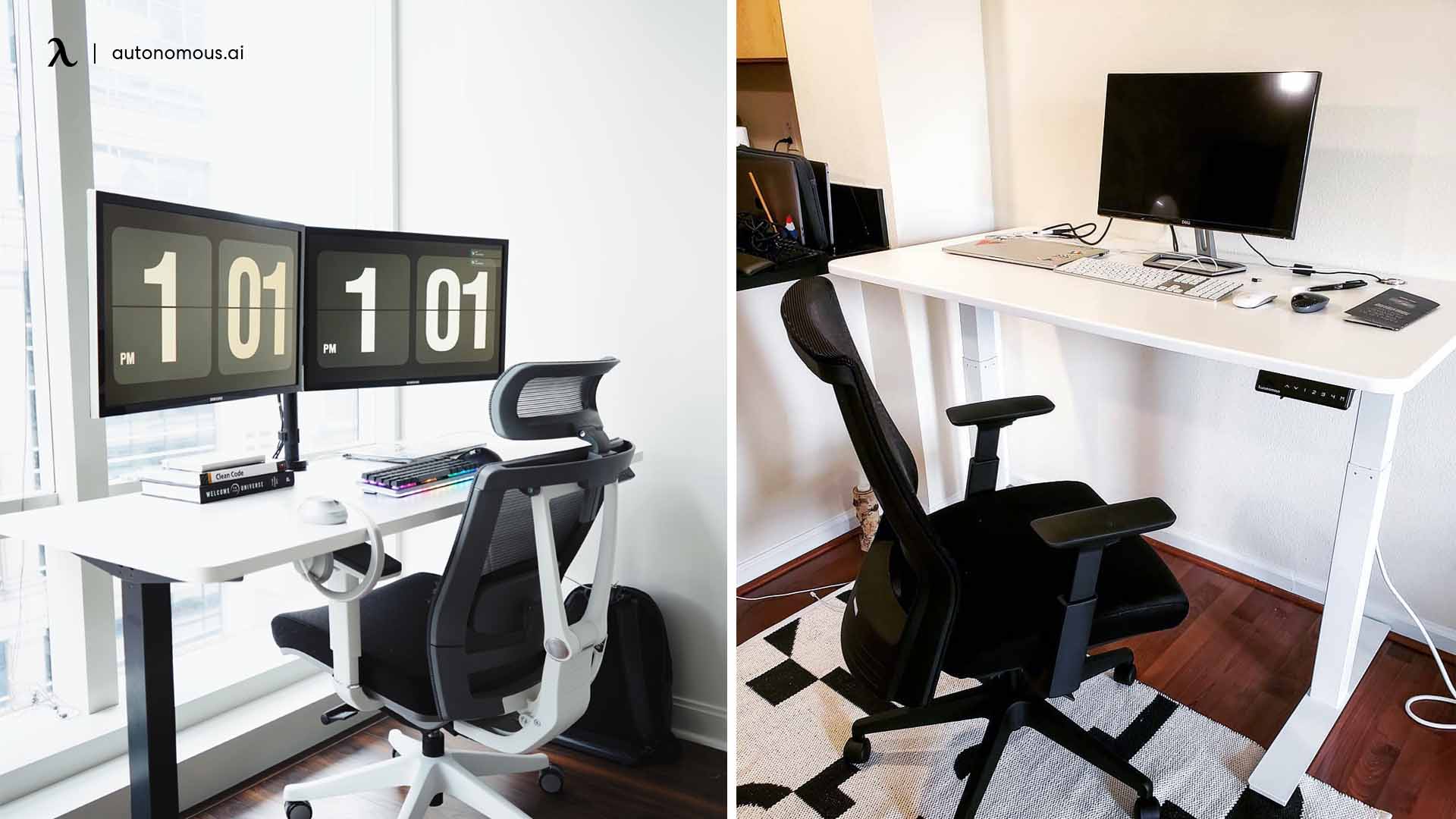
5. Adjust the Monitor(s)
The next step in your ergonomic workstation setup is to adjust the monitor. You’ve got to maintain the right spinal position while working to prevent neck, shoulder, or back injuries. Most people use a laptop on a short surface or the lap, which puts your neck into a forward flexion.
To reduce the strain on your head/neck, make sure the computer is at eye level when you’re sitting in your chair. You can purchase a laptop or monitor arm to help with this. Consider using books and other household items to save money.
As you sit up straight, adjust the monitor so that it’s at eye level or slightly under. That way, your neck and head are always neutral.
6. Correctly Position the Mouse/Keyboard
Now that you can see the monitor, the next step in your ergonomic accountant desk setup is to adjust the keyboard and mouse. This reduces the tension on the wrists and hands and can prevent carpal tunnel syndrome.
The forearm and hand should be straight, so keep the mouse and keyboard close to the edge of your desk. That way, you’re not leaning forward to get to it. If they’re too close, the hands aren’t going to be flush with the forearm and wrist.
- To have a fully ergonomically correct workstation, make sure the elbows are at 90 degrees and by your sides while you’re using the keyboard.
- Ensure that the hands are placed over the appropriate keys for typing. Since the chair is already adjusted properly, you may need to move the standing desk up or down.
- Once it’s in the right position, recheck your computer monitor.
You may need to use more books or a higher stand to achieve the right level.
Now, you’ve successfully learned how to set up an ergonomic workplace. However, we aren’t done yet! This is just the foundation of what you need to do. As an accountant, you might find yourself on the phone or using two monitors.
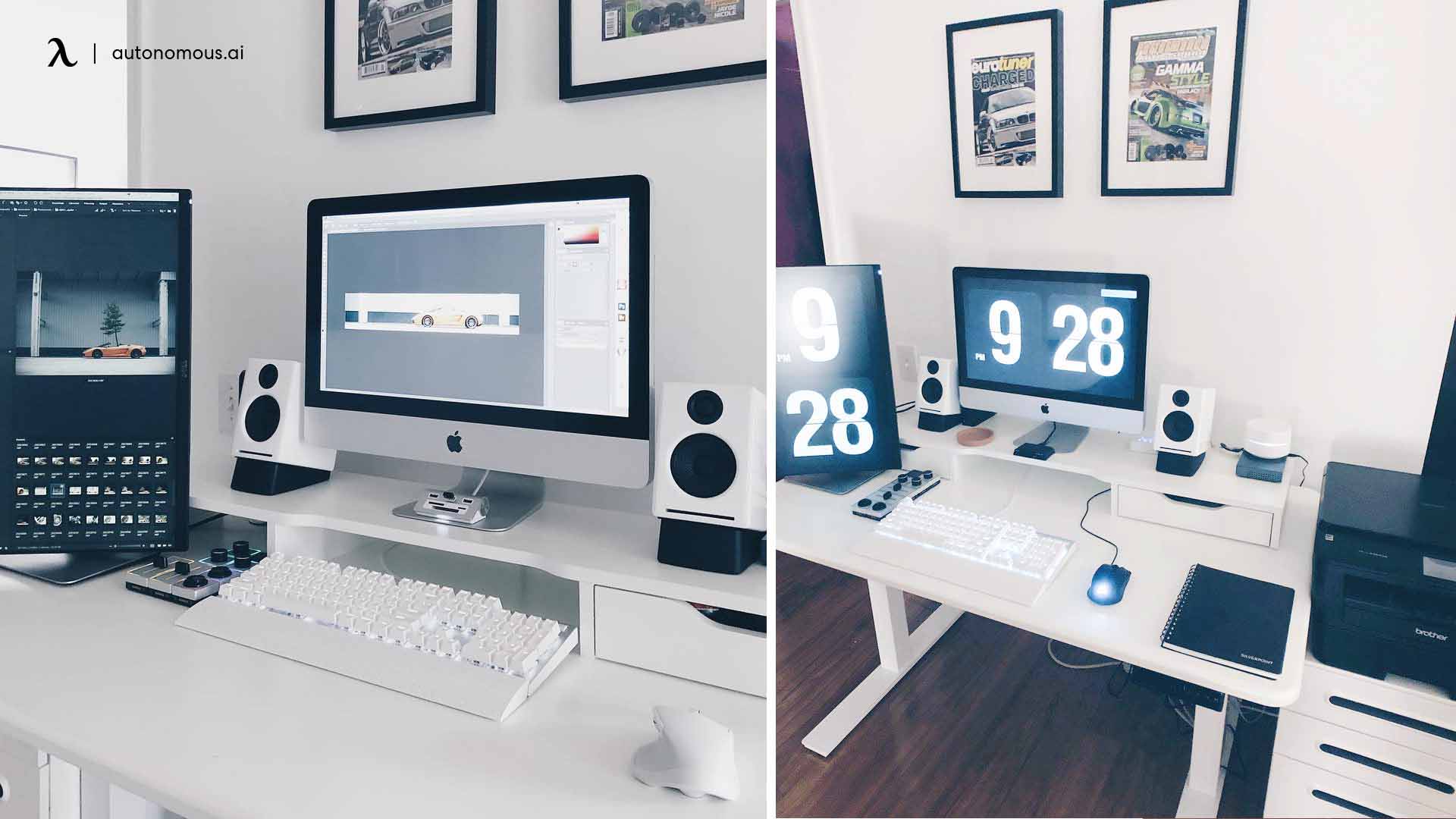
7. Stand Up and Continue Working
Learning how to set up an ergonomic accountant desk setup to stand and work is a great way to stay productive and focused on what you’re doing. While frequent effective breaktimes are important throughout the day, there’s no reason why you can’t work one to two hours without one. Still, you shouldn’t sit for more than 30 minutes at a time, so a standing desk can be beneficial.
Now that you have the seated ergonomic workstation setup in place, it’s time to adjust everything so that you can stand. The components on the desk aren’t going to move. Instead, you are going to push back your chair and stand up.
If you have an automated standing desk, you can press the button to raise it. Stand up straight and adjust it until the computer monitor is at eye level like before. At this point, check to ensure that your hands rest on the right keys, with your elbows positioned at 90 degrees and by the sides.
Such an ergonomic workstation setup reminds you to stand up straight and not slouch. Plus, you can work a little longer because you aren’t sitting for a long time. You can then program the seated and standing positions so that you can adjust things easily throughout the day.
8. Have the Right Tools
Your ergonomic office setup may require a dual monitor system. Make sure the second monitor is about the same size as the laptop or first screen. It should also be around the same height. Position it close to the first monitor so that you don’t have to turn your head much to see it.
Once that is positioned appropriately, you may want to invest in a document holder. It’s not required, but it is helpful when you’re crunching numbers or doing data entry. That way, you’re not looking down at a piece of paper. Instead, you’re looking ahead with proper spinal alignment. The right accessories can help you create an ergonomically correct workstation in your home.

9. A Focus on the Stand Up Ergonomically Correct Workstation
Your ergonomic accountant desk setup should focus on both standing and sitting. We’ve talked about each, but the same ergonomic workstation setup guidelines apply. Standing can add strain to the body, so you need to make sure that:
- The desk is tall enough for the arms to be comfortable
- You stand close enough to the desk to reach everything
- You move around and take frequent breaks
Remember, you’re going to need time to get used to working and standing in your ergonomically correct workstation. Don’t beat yourself up if you need to walk away for a few minutes every hour. This reduces the risk of burnout during the day.
Decor Themes for an Accountant Desk Setup
1. Minimalist Setup: Simple, Sleek, and Focused
If you value efficiency and clarity, a minimalist desk setup might be the ideal choice for you. Minimalism promotes a decluttered workspace, making it easier to focus on the task at hand. This design is all about simplicity and keeping only what’s essential in your workspace.
Key Features of a Minimalist Accountant Desk Setup:
- Neutral Color Palette: Opt for white, gray, black, or beige to create a clean, organized look. These colors help reduce distractions, keeping the space calm and focused.
- Functional Furniture: Choose a desk that’s sleek and spacious enough to accommodate your computer, files, and essential office supplies without feeling overcrowded.
- Decluttered Desk: Keep only what’s necessary on the surface. For an accountant, this means having a computer, a notepad, and perhaps a few pens for quick notes. Store other supplies in drawers or on shelves.
- Smart Storage Solutions: Utilize desks with built-in storage to keep papers, files, and other materials organized and out of sight. This setup allows you to keep your space clean without compromising on function.
Why It Works for Accountants:
Minimalism helps accountants stay organized and focused. Given the long hours spent reviewing documents and calculations, a minimalist desk reduces visual clutter, which can contribute to stress or fatigue. By keeping only essential items within reach, the accountant can streamline their workflow and increase productivity.
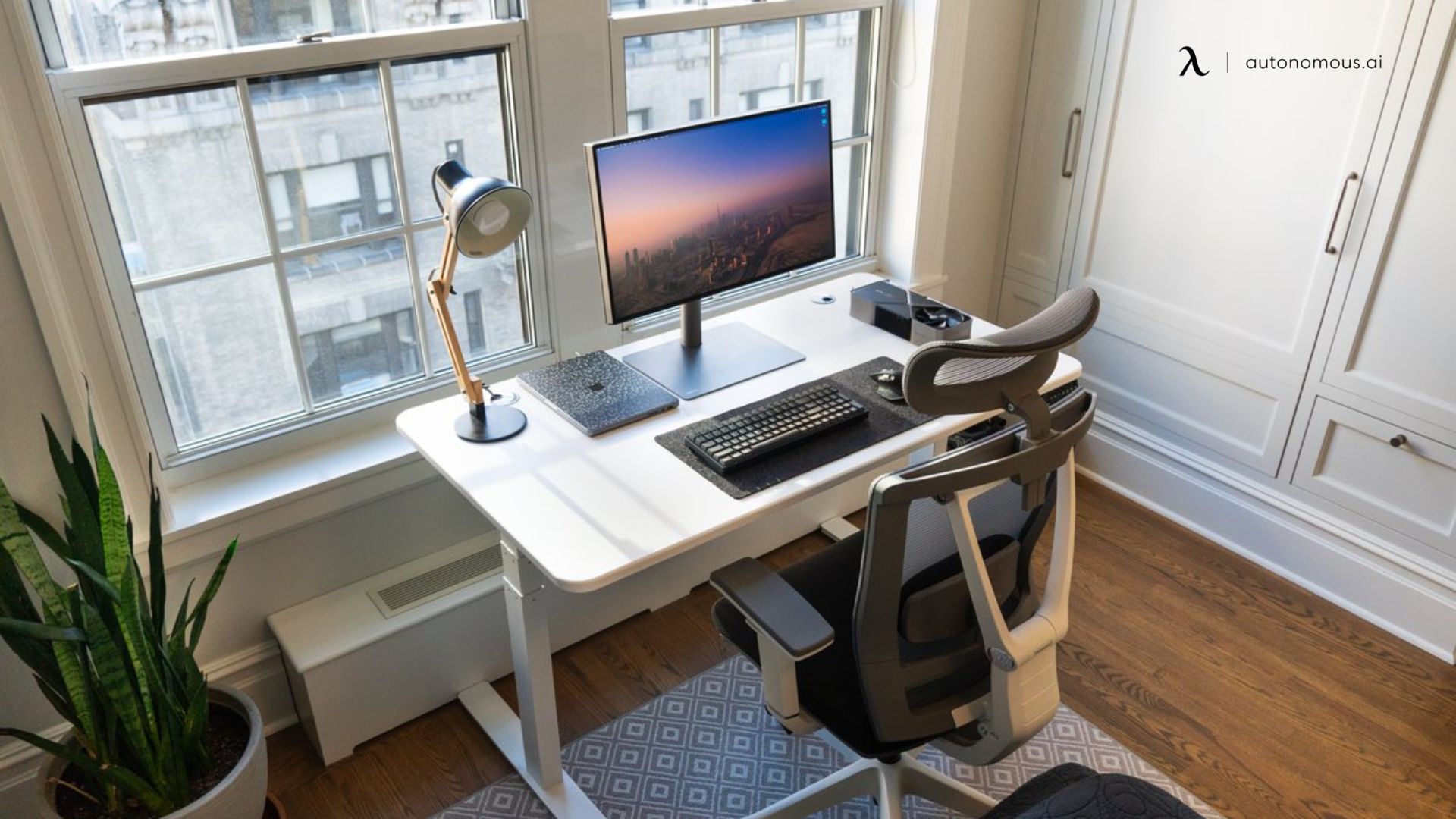
2. Modern Professional Setup: Sleek and Functional
For accountants who want a desk setup that combines style with functionality, a modern professional desk setup is the way to go. This theme focuses on clean lines, high-quality materials, and a sleek, contemporary design that boosts both style and productivity.
Key Features of a Modern Accountant Desk Setup:
- Sleek Desk: A desk made from materials like wood, metal, or glass adds a professional touch to the space. For example, a standing desk could be a perfect option for those who need to switch between sitting and standing during the day.
- Statement Accessories: Consider adding a stylish lamp, abstract artwork, or a chic clock to add some personality to the space without cluttering it.
- Tech-Friendly Setup: Opt for wireless devices like a keyboard, mouse, and speakers to reduce cable clutter. A docking station can also help keep all tech devices organized.
- Comfortable Chair: The modern desk setup isn’t complete without an ergonomic office chair that provides support for long hours. A good chair will promote healthy posture and prevent back pain.
Why It Works for Accountants:
A modern desk setup is great for accountants who want to maintain a high level of professionalism while staying productive. The sleek design promotes a clean, organized environment that’s conducive to focus and efficiency. The combination of functionality and style ensures that the desk setup aligns with both work needs and aesthetic preferences.

3. Cozy Setup: Comfortable and Inviting
Accounting work can often feel high-pressure, and creating a cozy, comfortable space is essential to reduce stress and increase focus. A cozy accountant desk setup focuses on comfort without compromising functionality.
Key Features of a Cozy Accountant Desk Setup:
- Comfortable Chair: Choose a supportive office chair with lumbar support. Look for a chair with soft padding and adjustable features to ensure comfort throughout long working hours.
- Warm Lighting: Swap harsh overhead lights for warm, ambient lighting. Desk lamps with dimmer switches are ideal for adjusting the light depending on the time of day.
- Wooden Furniture: Opt for wooden desks and shelves to create a warm, welcoming environment. Light or medium wood tones can help soften the space and add a natural touch.
- Personal Touches: Personalize the space with items like family photos, plants, or a few inspirational quotes. Plants like succulents or small potted flowers add color and life to the desk setup.
Why It Works for Accountants:
A cozy setup helps make the long hours spent at a desk more comfortable and less stressful. By incorporating soft textures, natural elements, and warm lighting, the workspace becomes inviting and relaxing. A comfortable environment can improve mental well-being, which is crucial for accountants who deal with complex tasks every day.
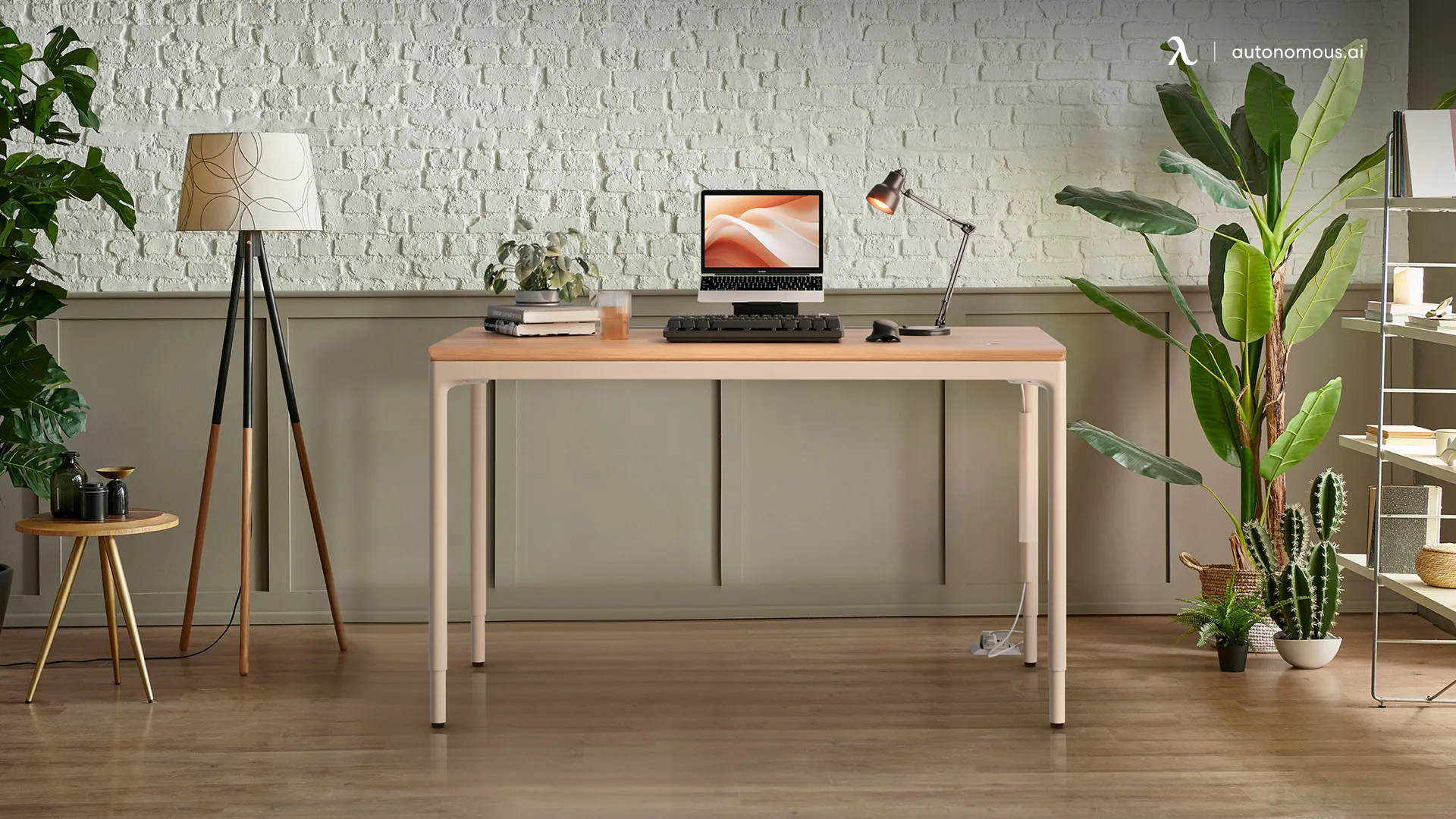
4. Scandinavian-Inspired Accountant Desk: Functional and Clean
The Scandinavian style emphasizes simplicity, functionality, and the use of light. This decor theme is perfect for accountants who want a clean, bright workspace that feels open and airy.
Key Features of a Scandinavian Accountant Desk Setup:
- Light, Neutral Color Scheme: Stick to whites, light grays, and natural wood tones. These colors promote a sense of calm and make the space feel larger and more open.
- Functional Furniture: Choose desks and storage solutions that focus on function. Scandinavian furniture tends to be simple yet stylish, with an emphasis on clean lines and practicality.
- Natural Materials: Incorporate wood elements into your desk and shelves to add warmth and texture to the space.
- Decluttered Workspace: The Scandinavian style favors minimalism, so keep your desk clean by storing papers and office supplies in drawers or cabinets.
Why It Works for Accountants:
A Scandinavian-inspired desk setup creates a serene, organized workspace that’s perfect for accountants who need to stay focused and productive. The simplicity of the design reduces distractions, and the natural materials create a warm, inviting environment.

5. Eco-Friendly Setup: Sustainable and Green
For accountants who are conscious of the environment, an eco-friendly desk setup is a great choice. This setup focuses on using sustainable materials and energy-efficient products to create a green workspace.
Key Features of an Eco-Friendly Accountant Desk Setup:
- Sustainable Desk Materials: Look for desks made from reclaimed wood or bamboo. These materials are eco-friendly and add a natural element to the space.
- Energy-Efficient Lighting: Use LED bulbs or energy-efficient desk lamps to reduce your carbon footprint while maintaining proper lighting for work.
- Recycled Office Supplies: Choose recycled paper, reusable pens, and other eco-friendly office supplies to reduce waste.
- Indoor Plants: Add some greenery to your desk setup with low-maintenance plants like succulents, which improve air quality and add a calming touch to your workspace.
Why It Works for Accountants:
An eco-friendly accountant desk setup is perfect for those who want to create a sustainable workspace while still maintaining functionality. Incorporating natural elements and energy-efficient products can reduce environmental impact and create a healthier, more enjoyable workspace.
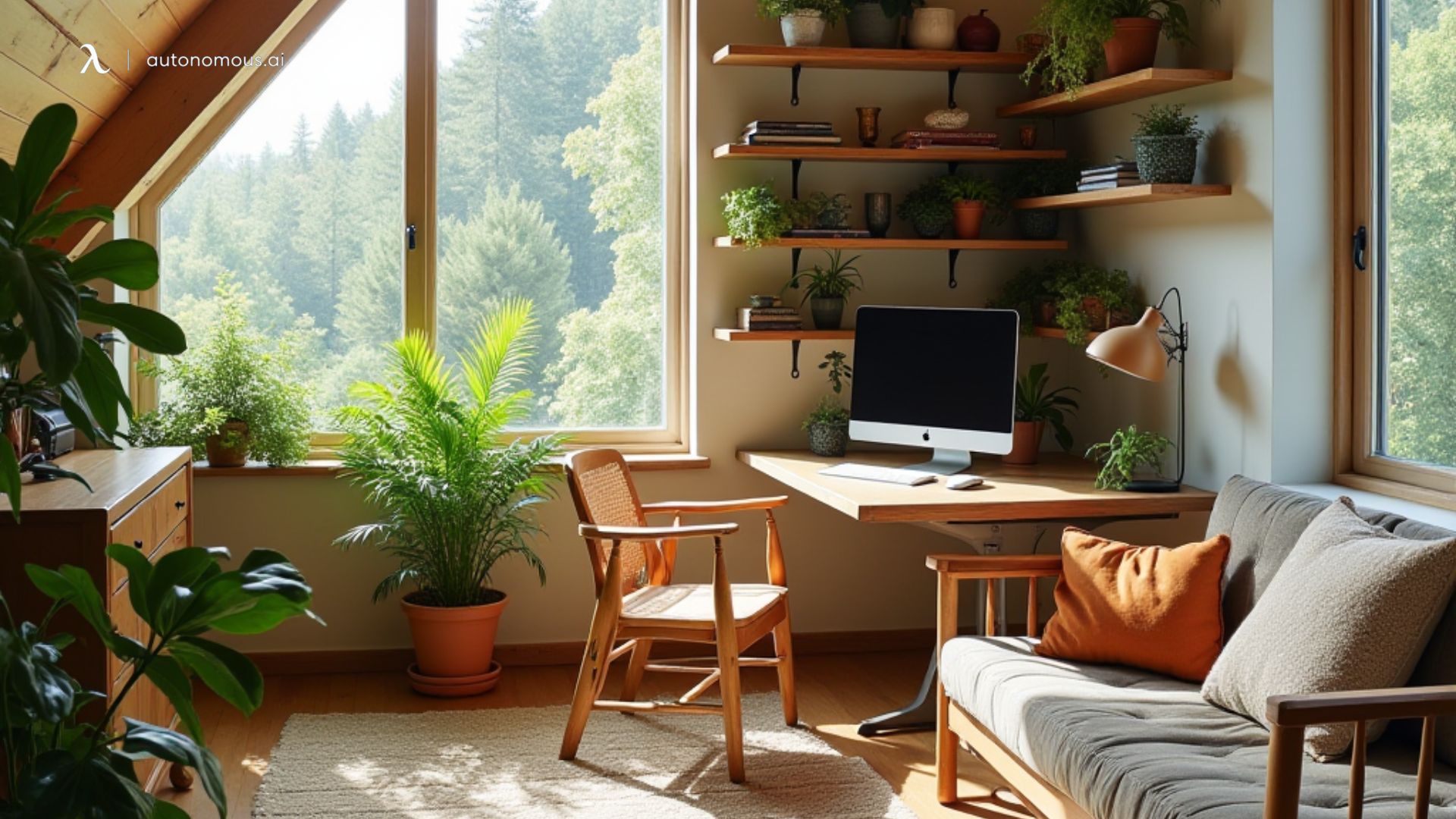
Other Tips for Accountants Working at Home
We have fully answered ‘what is an ergonomic workstation,’ but you can’t neglect your other needs. Make sure to eat healthily and get enough sleep. Take the time to prepare meals the night before so that you can heat them up and spend more time with the family.
The right ergonomic office setup is going to take you farther each day. Still, take a moment when you’re done working and get things ready for the morning. That way, you’re prepared and can start your first task immediately.
FAQs
We understand that you probably still have some questions. It’s not easy to justify paying more for a special workstation with appropriate standing desks and ergonomic chairs without knowing more.
Therefore, we’ve made it easy to find out why you need an ergonomic office setup and how to have a safe office space. Please take a moment to read these FAQs to see if they help you understand things better.
Why Is Ergonomics Important?
Ergonomics focuses on many things, but computer ergonomics is what most remote workers consider. If you spend most of your day at a desk working at the computer, you understand how challenging it is. You’re sitting for long periods and staring at a screen incessantly. This can do significant damage to your health, and you may notice a headache coming on, neck pain, and posture issues.
Computer ergonomics are essential to reduce the negative effects of sitting and working at a computer all day. It focuses on the placement of your desk, computer monitor, keyboard, and chair.
In a sense, ergonomics are important because you don’t want to do significant damage to your overall health. With the right systems and methods in place, you can reduce various issues, such as:
- Blurred vision and headaches – If your computer screen isn’t positioned correctly, you may experience blurred vision from staring at it. Likewise, you should think about adjusting the contrast and brightness to make it easier to view. Some people experience headaches, as well. When the monitor is far enough away to see clearly without leaning forward or straining your eyes, it’s easier to work.
- Carpal tunnel syndrome – This condition means that the nerves going from the hand to the upper arm are pinched, which results in pain and numbness. Most people get it from typing for extended periods. With the right ergonomics, your keyboard and mouse pad are positioned in a way to make it easier. Plus, they should have wrist support. Often, reducing the angle of the keyboard can help, too.
- Back and neck strain – Sitting for long periods takes a toll on your back. If you’ve got the computer at the wrong angle, you could also strain your neck. Ergonomics ensures that the chair has appropriate back support and is sturdy enough to reduce back pain and promote good posture. If it comes with a headrest, you can also prevent neck strain.
- Poor posture – Poor posture results from sitting at a desk for extended periods. You often slouch and get back pain. Using a chair with the right lumbar and upper back support is ideal. With that, you should think about buying a standing desk. That way, you move the desk to the chair so that your feet are firmly on the floor with your back straight.

What Is Poor Ergonomics?
Poor ergonomics includes things like putting your computer too far away, using the wrong keyboard, and having a chair that isn’t positioned correctly.
Generally, poor ergonomics result in various issues, which can be long-term. You may experience muscle fatigue, muscle imbalances, and muscle strain anywhere in the body.
Usually, muscle strains happen because you’re performing repetitive motions, such as using the mouse or typing. Sometimes, people feel tingling and numbness in the hands, but those who type frequently may also slouch forward from the shoulders. This puts more strain on the back and causes you to hunch up instead of keeping your shoulders from your ears.
Which Accessory Is Needed to Have a Safe Ergonomic Computer Workstation?
With so many ergonomic safety tips available, it’s almost impossible to narrow things down to one specific accessory. We have to say that the most important accessory for your computer workstation is the right desk.
Typically, you want to reduce the effects of sitting by standing up periodically. Though the right chair is essential, most people match their desk to the chair, and it should be the opposite. Set the appropriate chair height and then move the desk to meet your computer monitor needs.
Using a standing desk is highly beneficial. Even if you don’t plan to stand and work, you can adjust it to your chair and ensure proper posture while working. Though that’s not going to prevent issues in itself, it can alleviate the pressure of sitting. You should also take frequent breaks to reduce eye strain and give your wrists a rest, too.
Do Accountants Sit at a Desk All Day?
A common question is whether accountants spend all their time sitting at a desk. The answer is generally yes, but it varies depending on the type of accounting and the work environment. Accountants often sit at a desk all day, especially those who work in corporate or public accounting roles. They typically spend hours reviewing financial records, preparing tax documents, and working on reports. However, there is increasing awareness about the negative effects of sitting for long periods, which is why many accountants are switching to standing desks or incorporating movement throughout their day.
If you’re an accountant who spends a significant amount of time sitting at your desk, it’s important to ensure your desk setup is ergonomically friendly and promotes health. Consider using a height-adjustable desk to switch between sitting and standing, and invest in an ergonomic chair that supports your posture.

Conclusion
What is an ergonomic workstation? It means that you have the right chair, desk, and smart office accessories positioned correctly to reduce back pain and wrist strain. You’ve learned how to set up an ergonomic workplace in your home, so you can perform your accounting duties with ease.
The right accountant desk setup can make a significant difference in your productivity, comfort, and overall well-being. Whether you prefer a minimalist design, a cozy setup, or a more modern professional look, creating the ideal workspace is crucial for long hours of focused work. With the right furniture, accessories, and organizational tools, you can design a space that not only enhances your efficiency but also reflects your personal style.
By incorporating the decor themes and best practices outlined in this blog, you can create an accountant desk that fosters productivity, focus, and comfort, helping you perform at your best every day.
Spread the word
.svg)







